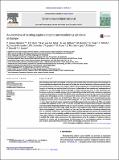Por favor, use este identificador para citar o enlazar a este item:
http://hdl.handle.net/10261/142320COMPARTIR / EXPORTAR:
 SHARE SHARE
 CORE
BASE CORE
BASE
|
|
| Visualizar otros formatos: MARC | Dublin Core | RDF | ORE | MODS | METS | DIDL | DATACITE | |

| Título: | An overview of existing raptor contaminant monitoring activities in Europe |
Autor: | Gómez-Ramírez, Pilar CSIC ORCID; Mateo, Rafael CSIC ORCID | Palabras clave: | Inventory Europe Contaminants Biomonitoring Raptors |
Fecha de publicación: | 2014 | Editor: | Elsevier | Citación: | Environment International 67: 12-21 (2014) | Resumen: | Biomonitoring using raptors as sentinels can provide early warning of the potential impacts of contaminants on humans and the environment and also a means of tracking the success of associated mitigation measures. Examples include detection of heavy metal-induced immune system impairment, PCB-induced altered reproductive impacts, and toxicity associated with lead in shot game. Authorisation of such releases and implementation of mitigation is now increasingly delivered through EU-wide directives but there is little established pan-European monitoring to quantify outcomes. We investigated the potential for EU-wide coordinated contaminant monitoring using raptors as sentinels. We did this using a questionnaire to ascertain the current scale of national activity across 44 European countries. According to this survey, there have been 52 different contaminant monitoring schemes with raptors over the last 50. years. There were active schemes in 15 (predominantly western European) countries and 23 schemes have been running for >. 20. years; most monitoring was conducted for >. 5. years. Legacy persistent organic compounds (specifically organochlorine insecticides and PCBs), and metals/metalloids were monitored in most of the 15 countries. Fungicides, flame retardants and anticoagulant rodenticides were also relatively frequently monitored (each in at least 6 countries). Common buzzard (Buteo buteo), common kestrel (Falco tinnunculus), golden eagle (Aquila chrysaetos), white-tailed sea eagle (Haliaeetus albicilla), peregrine falcon (Falco peregrinus), tawny owl (Strix aluco) and barn owl (Tyto alba) were most commonly monitored (each in 6-10 countries). Feathers and eggs were most widely analysed although many schemes also analysed body tissues. Our study reveals an existing capability across multiple European countries for contaminant monitoring using raptors. However, coordination between existing schemes and expansion of monitoring into Eastern Europe is needed. This would enable assessment of the appropriateness of the EU-regulation of substances that are hazardous to humans and the environment, the effectiveness of EU level mitigation policies, and identify pan-European spatial and temporal trends in current and emerging contaminants of concern. | Descripción: | Under a Creative Commons license.-- et al. | Versión del editor: | http://dx.doi.org/10.1016/j.envint.2014.02.004 | URI: | http://hdl.handle.net/10261/142320 | DOI: | 10.1016/j.envint.2014.02.004 | Identificadores: | doi: 10.1016/j.envint.2014.02.004 e-issn: 1873-6750 issn: 0160-4120 |
| Aparece en las colecciones: | (IREC) Artículos |
Ficheros en este ítem:
| Fichero | Descripción | Tamaño | Formato | |
|---|---|---|---|---|
| raptoreurope.pdf | 899,28 kB | Adobe PDF |  Visualizar/Abrir |
CORE Recommender
SCOPUSTM
Citations
127
checked on 13-abr-2024
WEB OF SCIENCETM
Citations
124
checked on 23-feb-2024
Page view(s)
341
checked on 18-abr-2024
Download(s)
328
checked on 18-abr-2024
Google ScholarTM
Check
Altmetric
Altmetric
Este item está licenciado bajo una Licencia Creative Commons

